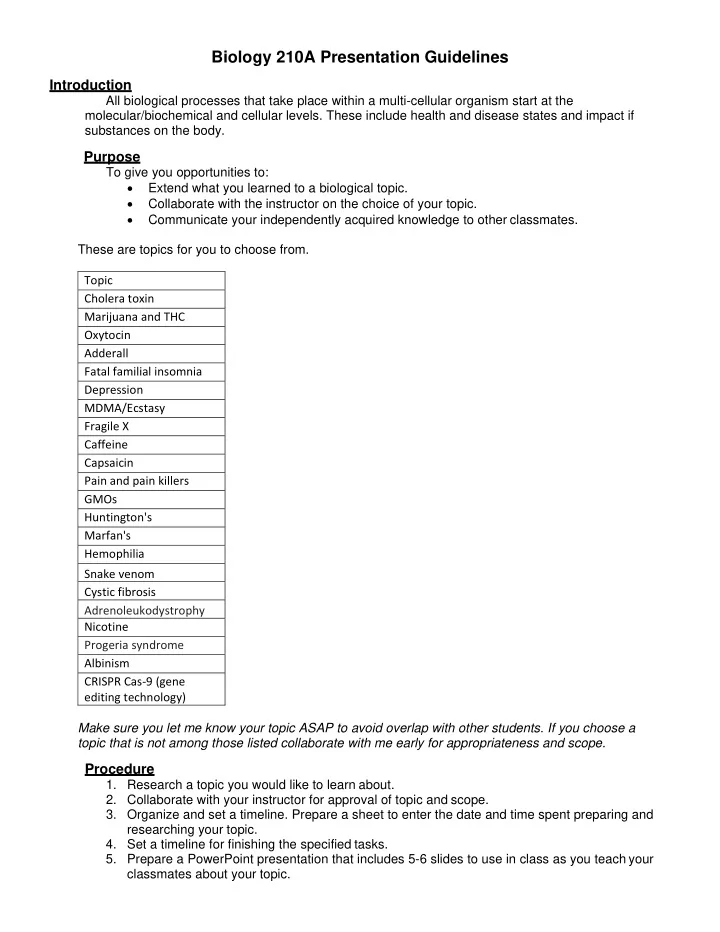

Biology 210A Presentation Guidelines Introduction All biological processes that take place within a multi-cellular organism start at the molecular/biochemical and cellular levels. These include health and disease states and impact if substances on the body. Purpose To give you opportunities to: • Extend what you learned to a biological topic. • Collaborate with the instructor on the choice of your topic. • Communicate your independently acquired knowledge to other classmates. These are topics for you to choose from. Topic Cholera toxin Marijuana and THC Oxytocin Adderall Fatal familial insomnia Depression MDMA/Ecstasy Fragile X Caffeine Capsaicin Pain and pain killers GMOs Huntington's Marfan's Hemophilia Snake venom Cystic fibrosis Adrenoleukodystrophy Nicotine Progeria syndrome Albinism CRISPR Cas-9 (gene editing technology) Make sure you let me know your topic ASAP to avoid overlap with other students. If you choose a topic that is not among those listed collaborate with me early for appropriateness and scope. Procedure 1. Research a topic you would like to learn about. 2. Collaborate with your instructor for approval of topic and scope. 3. Organize and set a timeline. Prepare a sheet to enter the date and time spent preparing and researching your topic. 4. Set a timeline for finishing the specified tasks. 5. Prepare a PowerPoint presentation that includes 5-6 slides to use in class as you teach your classmates about your topic.
Please save your PowerPoint presentation ion a USB flash drive or in your email to download before the beginning of the presentations. Instructions I. Presentation time is limited to 8 minutes per person. PowerPoint presentations are limited to a maximum of 6 slides. Time yourself by practicing your own presentation before coming to class. Limit the scope of your presentations to the following: 1. Introduce your topic through the title. 2. Include an outline or list of objectives you plan to cover in your presentation. 3. Brief description of the condition or topic. If your presentation is about a disease, don’t provide too many clinical symptoms. 4. You can include a reference for others who are interested in learning more. 5. Use appropriate figures to explain the cellular and molecular/biochemical basis and the impact at the tissue, organ, or organs system. This should be the focus of your presentation. 6. Include a final slide of the references you used as your sources of information. II. Prepare an assessment tool (question or activity) to check if your classmates learned the major point you want them to take from your presentation.
Tentative Rubric for Student & Instructor Evaluations Possible points 3 2 1 Originality Creativity and originality Creative and original Lacks creative and/or engages audience original effort Preparedness & All aspects of the subject Most aspects of the Some aspects of the were covered and the subject were covered subject were covered Content presentation was well and the presentation and the presentation Coverage prepared and presenter was well prepared. were not well understood and had Some major prepared or not a complete grasp of subject aspects were not completely understood understood Presentation visuals All Visuals support the Most Visuals support the Major sources of errors or material. All aspects of material. Most of the lacking of visual support materials to be covered are material to be covered is but an attempt was made represented represented Delivery Presenter has good voice Presenter has some voice Very poor inflection and does an inflection and does attempt to communication that outstanding job in the communicate clearly. A few interferes with the speaking aspect of the errors in communication delivery of information presentation Several sources of Limited sources of Very limited sources of Sources of information information were properly information were properly information that were not referenced referenced properly referenced Following Instructions All instructions for the Most of the instructions Few of the instructions presentations preparation for the presentations for the presentations were followed preparation were followed preparation were followed Total score Each category will be scored according to the following scale: 3 = excellent, 2 = good, 1= poor, and 0 = unsatisfactory.
Recommend
More recommend